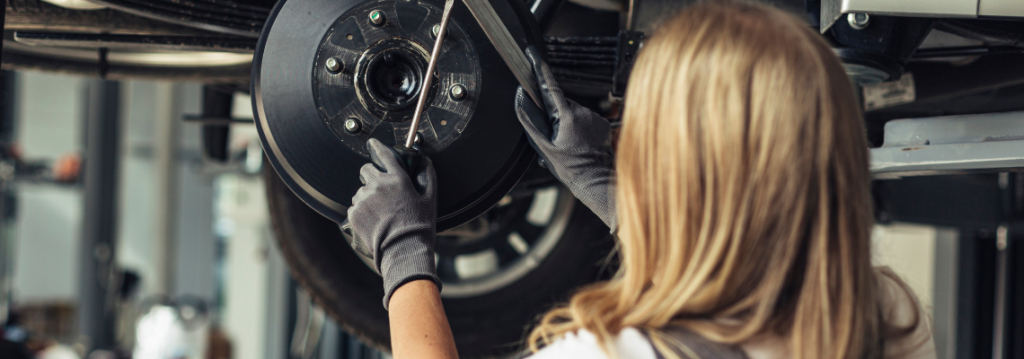
Have you ever pressed the brake pedal and wondered what actually happens to bring your car to a stop? Most drivers trust their brakes without thinking much about how they work. Yet, understanding the essential parts of your car braking system can help you maintain it better, avoid costly repairs, and ensure your safety on the road.
At Smooth Your Drive, we meet countless car owners who are unsure whether their brake pads or brake discs need attention. Both play different roles in braking, but they are equally important to your safety.
This blog explains the roles of brake pads and discs, how they differ, signs of wear, and why regular maintenance tips are key to safe driving.
Understanding the Car Braking System
The braking system is one of the most vital safety mechanisms in any vehicle. While your engine moves you forward, it is your brakes that give you control and peace of mind.
Most modern vehicles use a disc braking system. Here’s how it works:
- When you press the brake pedal, hydraulic fluid transfers pressure to the brake caliper.
- The caliper pushes the brake pads against the brake disc.
- Friction between the pads and the disc slows the wheel rotation and brings the car to a stop.
It’s a simple process on the surface, but the efficiency and safety of your braking depend on the condition of both pads and discs. At Smooth Your Drive, our expert technicians thoroughly inspect this system during routine servicing to ensure every component works seamlessly.
What Are Brake Pads?
Brake pads are rectangular-shaped components housed inside the brake caliper. They are made with friction material attached to a metal backing plate. When you apply the brakes, they press against the brake disc to create the friction required to stop the vehicle. Functions of Brake Pads:
- Generate friction that slows the vehicle.
- Protect the disc by acting as a buffer between metal components.
- Convert kinetic energy into heat during braking.
Types of Brake Pads
- Organic pads: Affordable and quiet, but wear out quickly.
- Semi-metallic pads: Durable and heat-resistant, but can be noisy.
- Ceramic pads: Premium option with long lifespan and minimal noise, though more costly.
At Smooth Your Drive, we help customers choose the right type of brake pads based on their car model, driving habits, and budget.
What Are Brake Discs?
Brake discs, also known as rotors, are round metal plates attached to the wheel hub. They rotate along with the wheels and provide the surface for the pads to press against.
- Functions of Brake Discs.
- Serve as the contact point for the brake pads.
- Absorb and dissipate the heat produced during braking.
- Provide consistent performance even under heavy braking conditions.
Discs are generally made from cast iron, although high-performance vehicles may use ceramic or composite materials. Ventilated discs, with internal channels, are commonly used to improve cooling and reduce heat build-up.
How Brake Pads and Brake Discs Work Together
Brake pads and brake discs are interdependent. The pads create the friction, while the discs manage the heat and provide the stopping surface. Without pads, the caliper would damage the discs. Without discs, the pads would have no surface to act upon.
Imagine walking barefoot on a rough floor. Your feet would wear out quickly. Shoes protect you, just like pads protect the discs. On the other hand, without the floor, walking would be impossible, just as discs are essential for braking.
This is why our mechanics at Smooth Your Drive always recommend inspecting both components together during brake repair and maintenance, rather than focusing on one in isolation.
Differences Between Brake Pads and Brake Discs
Although closely connected, brake pads and brake discs differ in material, lifespan, and maintenance needs. Brake pads wear out faster because they are designed to absorb most of the friction. They are cheaper and easier to replace, but need more frequent attention. Brake discs are stronger and last longer, but they are more expensive to replace if damaged.
In short, pads are the friction creators, while discs are the friction absorbers. Together, they form the heart of the car braking system.
Signs That Brake Pads Need Replacement
Recognising when your brake pads are worn out can save both money and safety risks. Watch out for these common signs:
- Squealing or squeaking noise when braking.
- Grinding sounds, which indicate pads are fully worn down.
- Reduced braking performance, such as longer stopping distances.
- Brake warning light in vehicles equipped with sensors.
At Smooth Your Drive, we replace worn-out brake pads with genuine parts and ensure your discs remain protected.
Signs That Brake Discs Need Attention
Brake discs are more durable, but they can also fail if neglected. Warning signs include:
- Vibrations or pulsations when braking, often caused by warped discs.
- Deep grooves or cracks visible on the disc surface.
- Burning smell or smoke after braking, caused by overheating.
- Unusual noises even after new pads have been fitted.
Our service team at Smooth Your Drive performs detailed inspections to check for these issues and provides honest recommendations on whether resurfacing or replacement is required.
Why Brake Repair and Maintenance Is Essential
Your braking system is not an area to take risks. Regular brake repair and maintenance ensures both pads and discs are in proper working order. This not only protects you but also reduces the risk of expensive repairs later. During servicing, mechanics will:
- Measure brake pad thickness.
- Inspect discs for cracks, grooves, or warping.
- Check brake fluid levels.
- Ensure overall braking efficiency.
A well-maintained braking system is your strongest safeguard against accidents.
Tips to Extend the Life of Brake Pads and Discs
While normal wear and tear is unavoidable, you can slow the process with good driving habits:
- Avoid unnecessary hard braking.
- Maintain safe distances to reduce sudden stops.
- Keep your vehicle’s load within recommended limits.
- Schedule regular inspections at a reliable service centre.
By adopting these practices, you will not only extend the life of your braking system but also enjoy smoother, safer rides.
Conclusion
The difference between brake pads and brake discs may seem technical, but as a car owner, it is valuable knowledge. Brake pads generate friction, while brake discs provide the surface and manage the heat. Both are crucial to your car braking system, and both need proper attention. At Smooth Your Drive, we specialize in providing reliable, transparent, and efficient brake repair and maintenance. From replacing worn-out pads to repairing discs, our expert mechanics ensure your braking system is always performing at its best. Because when it comes to road safety, your car deserves nothing less than the best.


